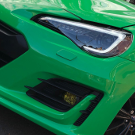Leaderboard
Popular Content
Showing content with the highest reputation on 08/05/20 in all areas
-
1 pointHi All, Back at the start of the lockdown I decided I needed a project to look forward to whilst working from home and I'd been toying with the idea fitting a turbo/supercharger for a while. Only problem was a i really fancied doing the installation work myself, so after some research (and a test drive in the Abbey demo car) I settled on ordering the Harrop supercharger kit from @Mark@Abbey M/S . Now it turns out that Abbey don't sell many of these kits for DIY fitment, so i figured I'd write up a bit of a review in the hope others might find it useful and may even have a go themselves in the future. Existing mods Prior to fitting the supercharger I'd had a TD manifold fitted and a remap by Abbey which took the car up to about 180bhp at the hubs and around 140ibft of torque. I’ve also fitted several cat backs ultimately settling on the TD super res. What's included? So for the money you get Harrops custom built manifold mated to an Eaton TVS1320 blower plus all the bits and pieces required to make it work on the car (including a special tool for reforming the A/C pipe around the supercharger). I have to say on unboxing the kit i was really quite impressed, it includes just about everything you need to get the job done. Complete with a signed off opy of the picking sheet when the kit was put together at Harrop so you can see someone's taken the time to put it all together and you can easily check it's all there. The only bit that wasn't included was the coolant for the charge cooler but that's not the end of the world as it's a standard GM coolant so you can get the anywhere. In addition Mark also provided; the loan of an EcuTEK programming cable and dongle, a base map to get the car running, distance mapping (more on that later) and a session on the dyno for final map tuning and a power run. The fitting process This is the bit i'd imagine will be most of interest to other as there's not an awful lot of info online about it. Now the first thing I must stress is much in the style of the Pirates code (see one of the Pirates of the Caribean films for the full reference), the instructions are really for guidance only. They'll point you in the right direction (usually getting you 95% of the way there) but there will be times where a little bit of thinking is required. Most of those moments centred more around the removal of the OEM items rather than the refitting of the new bits, which in all honest I kinda expected and it wasn't really that difficult. That being said Mark was always at the end of phone when I had bits i wasn't sure of. In terms of what was required to fit the kit, i did it over the course of a week with the front end in the air on a set of drive on ramps. If you're going to this way it's worth considering fitting the chargecooler/chargecooler pump/pipe work first (the instructions have it last). That way all the work from underneath is done before you start removing things like the fuel rails. Also it's worth following a bit of advice from one of the American forums and remove the undertray all the way back to the footwell, it's sods law you'll drop something and it will almost certainly land on that under tray. As for tools, the only specialist tools required were the former for bending the A/C pipe out of the way and that was included in the kit (it's worth making sure you have a substantial G clamp though as bending that pipe is hard work). Just about everything else can be done using a socket set and the odd screwdriver/allan key. The only minor issue i did find was that clearance between the TD manifold and the crank pulley was a bit tight, so we had to grind a little bit off the flange to fit the auxilliary belt. That and getting the fusebox apart to fit the chargecooler pump wiring but that's simply a case of trusting that it's more solid than you think. Once you're happy leavering things knowing what you can get away it comes apart fairly easily. Mapping Now the mapping process is something I've never really been involved in before so it was quite interesting. So Mark talked me through the initial process of connecting the EcuTEK software to the car and querying the ECU. He then sent over a base map which allowed me to get the car running and. From there it was a case of going out taking data logs starting keeping the car at low load/rpm initially then gradually increasing load/rpm as Mark tweaked the mapping till we got to a point where i could run it all through the rev range. This was the first point where the supercharger relay began to put a smile on my face, running it all the way through the rev range in third is really quite addictive. The way the torque just builds and builds is fantastic. After that i got the car booked in on the dyno for the final tune and a power run (the results of which are attached), the headline figures being approximately 240bhp (up 60bhp) and 200ibft or torque (also up around 60ibft). Conclusions to wrap up, i have to say i don't regret going down the DIY fitment route and i'd highly reccomend it to anyone that's half decent with a set of spanners. Fitting this kit really isn't all that complicated and the feeling of pride when you fire it up for the first time is just fantastic. That and of course you get a car at the end of it with some serious performance, the bit where it really comes alive is the the way it pulls through third/fourth/fifth. Where it used to run out of steam the car now just pulls like a train. With the added bonus that the fuel consumption hasn't taken to much of a hit, granted if you really press on then it drops quite quickly but on a gentle cruise i can still get 32-33mpg. I'd also just like to say a big thanks to Mark and the team at Abbey Motorsport. They were really helpful through out the process (Mark even delivered the kit personally after Parcel Force decided it was to heavy but didn't bother calling him to say so) and it was good to know that Mark was at the end of the phone should i need some advice. If anyone has any questions then fire away, i'm more than happy to help.
-
1 pointThanks yeah I thought the same RE the rivets. Its on the road Well I'm glad to say the BRZ flew through the MOT, with one advisory for a nail in the rear tyre, meh I have new wheels going on soon. So glad to get it to where it is, but this is just stage 1. Stage 2 involves modding it, plenty to come. Therefore its now taxed and insured. Heres a picture as it sits now: Untitled by James Baker, on Flickr
-
1 pointNearly Back On The Road So I set out to give a true reflection of what it would take to get the car back on the road. I have done all the work myself minus the frame shop straightening the front end/welding on the new slam panel and the respray itself. If you take out of the consideration any mods I've purchased that weren't needed such as rear lights/headunit/STI parts etc and just look at what it would take to get a similar 86/BRZ back on the road with similar damage I have spent as follows. Exactly as I've done it with facelift front end and new bumper/wings plus full colour change: Total on the road cost: £8930.46 That includes: Crash Damaged BRZ £4200 Used Bonnet £150 Used Crash Bream £50 Used Rad £20 Used A/C rad £20 Used Fans £20 Used Airbox and washer bottle £100 Odd used and new clips, brackets, fog lights, wiring, rear bumper etc £200 New Slam Panel Subaru £306 New Front wings and brackets, top plastic grill trim, 4x rubber bushings for rad assembly Toyota £309 New Vland Headlights £380 New Facelift front bumper with all the brackets, grills etc £617.92 New Headlight rubber seals(BRZ Only) Subaru £58.14 New Headlight washer jet covers Subaru £70 New Various bolts Subaru £29.24 Labour for frame shop to straighten the car £380 Respray in Porsche RS Green £2000 (Note for those that ask why so cheap I did all the labour in terms of stripping the car minus the bonnet/doors/boot lid For that above cost I have a 2013 BRZ with around 40k on the clock, spotless interior, heated seats, spotless exterior which is unique and you wont see another one in that colour, black headlights etc. Yes I could have bought a working 86 for that sort of price (Only seen very rough BRZ's sub £10k) but it would possibly have higher mileage, not as in good condition and certainly not unique. It would also have the pre-facelift front end which im not a massive fan of. So for me I am more than happy with it as it stands and gives me a solid base to start modifying. Getting it on the road even cheaper: Now I could have got it on the road for much cheaper if I had waited around for used parts that matched the body colour and didn't insist on retro fitting a facelift front end. This would have avoided £2000 in bodyshop costs straight away, plus the used body parts would have been a lot cheaper than the new bits I went for like the front bumper and wings. Total on the road cost: £6383.54 That includes: Crash Damaged BRZ £4200 Used Bonnet £150 Used Crash Bream £50 Used Rad £20 Used A/C rad £20 Used Fans £20 Used Airbox and washer bottle £100 Odd used and new clips, brackets, fog lights, wiring, rear bumper etc £200 New Slam Panel Subaru £306 Used Front wings and brackets, top plastic grill trim, 4x rubber bushings for rad assembly £300 New Vland Headlights £380 Used Front Bumper £150 New Headlight rubber seals(BRZ Only) Subaru £58.14 New Various bolts Subaru £29.24 Labour for frame shop to straighten the car £380 Yes I was lucky with some of the used parts coming up super cheap, but if I can find bargains, others can. Sam Nadeem from SJ Autosports is a great source of well priced used parts for 86's/BRZ's in the UK. I did all the work with a Halfords tool kit and a Ryobi impact gun. I've never rebuilt a crashed car before so have learn't a lot along the way. Now its time for its MOT tomorrow, then tax and insurance. Once thats done its off the bodyshop for its final polish now its all back together then modifications begin. Very happy its gone from this: Untitled by James Baker, on Flickr To This: Untitled by James Baker, on Flickr


